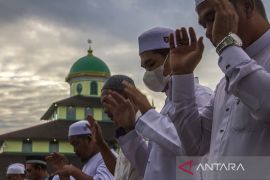Banjarmasin, S Kalimantan (ANTARA) - Banjarmasin Jami Mosque which now stands majestically on Jalan Masjid Jami No. 01, Antasan Kecil Timur Urban Village, North Banjarmasin, has become the pride of people as a center for da'wah and syiar Islam.
Being the second oldest mosque (242 years) in the city of Banjarmasin after the Sultan Suriansyah Mosque (469 years) on Jalan Kuin Utara, Jami Mosque, also known as the Sungai Jingah Jami Mosque. Firstly built on Saturday 17th Shawwal 1195 Hijri coinciding with 1777 Miladiyah (AD), it still leaves historical objects, namely a pulpit and a traditional drum locally called dauh (Indonesia: beduk) .
"There is an inscription with Arabic letters on the pulpit explains the establishment of the mosque. Then the beduk was also taken from the mosque building originating in the Martapura Riverside," said Secretary of the Banjarmasin Al Jami Foundation Drs H Radiansyah.
In the history of its origin, the mosque was not in its present place. But on the banks of the Martapura River, which is about 200 meters away. It was built during the reign of Sultan Tamjidillah.
"After more than 100 years, the building was eroded by the river and it was feared to collapse until in 1934 it was moved to its current location and re-built from beginning," Radiansyah said, beginning the historical story of the Jami Mosque.
The name of the Jami Mosque itself means collecting small-scale places of worship that existed before. To unite the congregation, a large mosque that was quite magnificent was built with the name Jami Mosque.
The development on Sunday 16th of Zulhijjah 1352 Hijriyah or 1934 was under the leadership of Mufti H Ahmad Kusasi. It was self-help funded by the Banjarmasin people living on the banks of the river.
"The community worked together. Even when building the basic foundation by transporting sand from Kembang Island with the permission of the authorized government at that time. Building materials also on the endowments and contributions of Muslims," Radiansyah recalled the struggle of ancient communities to build mosques.
In its journey, the mosque with a Banjar and colonial architecture which color is predominantly green, with ironwood base material, has been renovated three times. But the renovation did not change the basic shape of the main building, only replaces a number of parts have been damaged by age to become new again with the best quality in time.
The initial main building is still standing firmly with 17 main pillars symbolizing the 17 rak'ahs in the daily fardhu prayer. The upper part of the dome to the lowest terraced five symbolizes five daily prayers and five pillars of Islam.
The spacious main hall of the mosque is 40x40 or 1,600 square meters plus the mihrab (a niche in the wall of a mosque) and plazas surrounding the mosque with three pendopo as the main door. In addition, it is equipped with 38 entrances to make it easier for pilgrims to enter the main room with a capacity of 5,000 people.
The major renovations have been carried out three times. First during the Governor of South Kalimantan Drs. H Gusti Hasan Aman (1995-2000) who replaced the face wall of teak. Then Governor Sjachriel Darham (period 2000-2005) renovated the floor and support of the wall which had been eaten by termites, that it had to be casted and installed in ceramics.
Furthermore, during Governor H Rudy Ariffin towers were built and the transfer of location of the Bhakti 1 Islamic Kindergarten and Alquran learning center for children and the Al-Jami Banjarmasin Islamic College (STAI) to the rear area of the mosque.
The front page expansion was also carried out by dismantling the mosque's secretariat building to become a parking area. The courtyard of this mosque could accommodate up to 15,000 worshipers during the Eid Al-Fitr and Eid al-Adha prayers and the recitation led by KH Zuhdiannoor or popularly called Guru Zuhdi.










